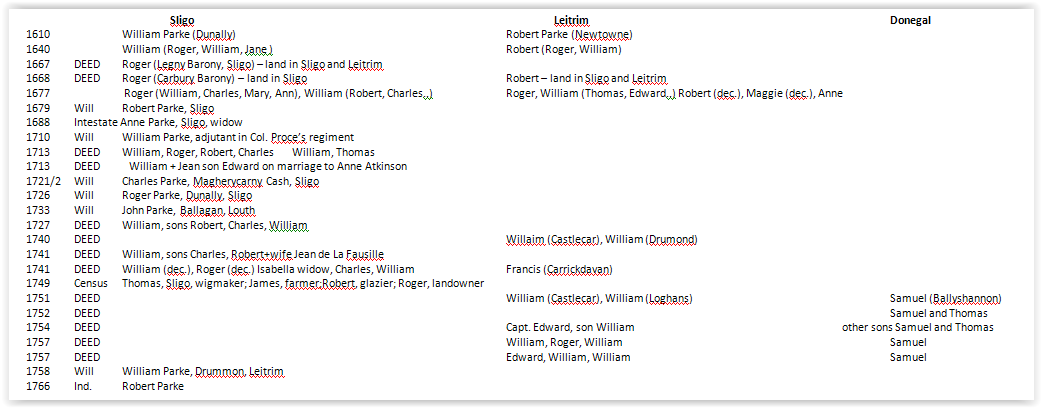Family membership now becomes rather difficult to elucidate, because there are deeds relating to transactions between several William, Charles and Roger males to allocate to different families. There is a William at Castlecar near Manorhamilton,Leitrim (deed dated 1711) who has dealings with the Dunally Parke family. This is most likely to be William Parke6.
At this point it is probably instructive to divide the families into:
Sligo Branch (Dunally/Doonalley, Rabraghan, Shannon Oughter, Drummons);
Leitrim Branch (Newtowne, Manorhamilton, Castlecar, Drumond, Loghans);
with Donegal (Ballyshannon, Carrickdavan, Creevy, Ballybegly?) interleaving at various stages.
Using this scheme (for a couple of generations, at least) we have, basically, descendents of William Parke4 belonging to the Dunally line and descendents of Robert Parke3 belonging to the Leitrim line.
One major difficulty is that the various townlands/places mentioned in the deeds seem to be no longer used. For example, we see Drummons in Sligo, Drummond in Leitrim and even Drummans mentioned in deeds. Searching for these in online databases, however, produces mixed results with these, and slight variants, turning up in 33 Baronies! If we look for Rabraghan, Shannon Oughter or Loghans we find nothing.
It appears, from “Deeds, etc.”, that ownership/leasehold of Dunally changed hands between the Leitrim and Sligo branches several times in ensuing generations, thus producing difficulty in tracing lineage, and it may have assumed status as the “Family Home” following the loss of the castle on Lough Gill.
To assist in sorting the various persons involved, we can make some assumptions:
- Families tend, mostly, to remain in an area with only gradual spread outside of that location.
- The average age of marriage was 21 years old, with children born within the next 20 years.
- Although 99% of names (in the various deeds, etc.) are male, there must also be female children
We will suggest date ranges for when generations are born, marry, have children and then die, as in the following schedule:


This scheme, in conjunction with a very brief glance at the entries in the Registry of Deeds (extracted by Patrick Parkes):

helps us to produce an apparent family tree (following pages) for the first few generations in Sligo and Leitrim: